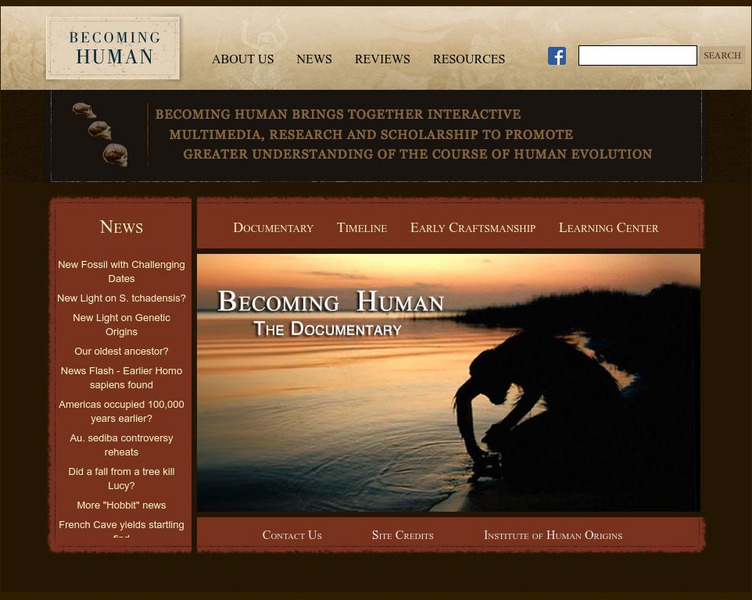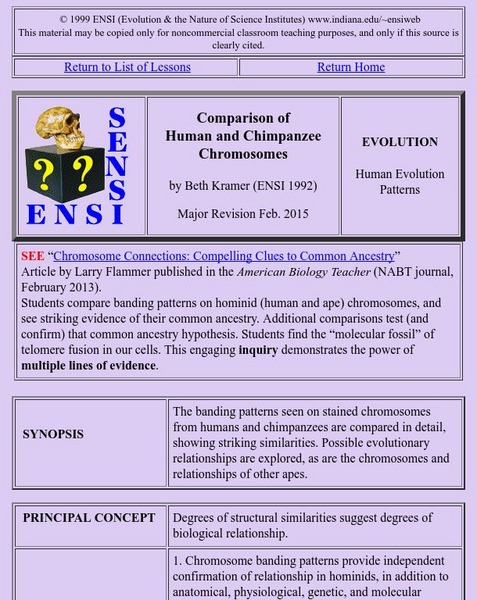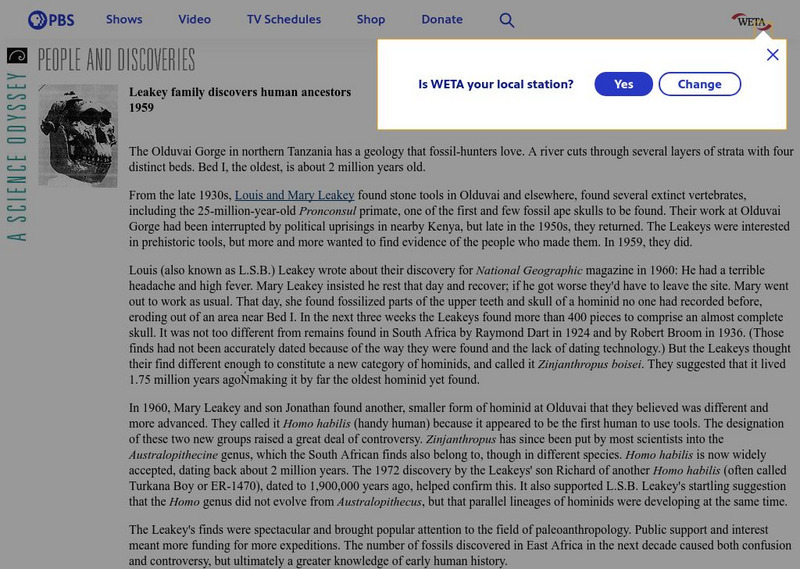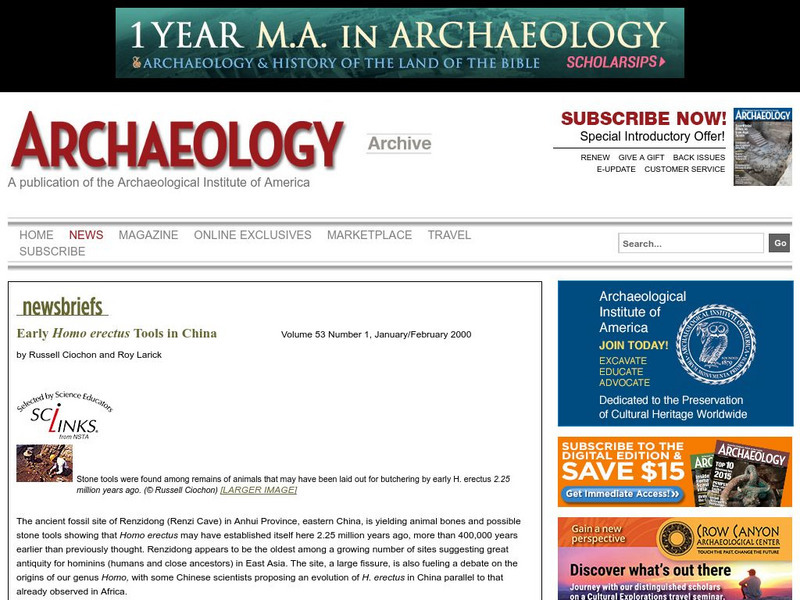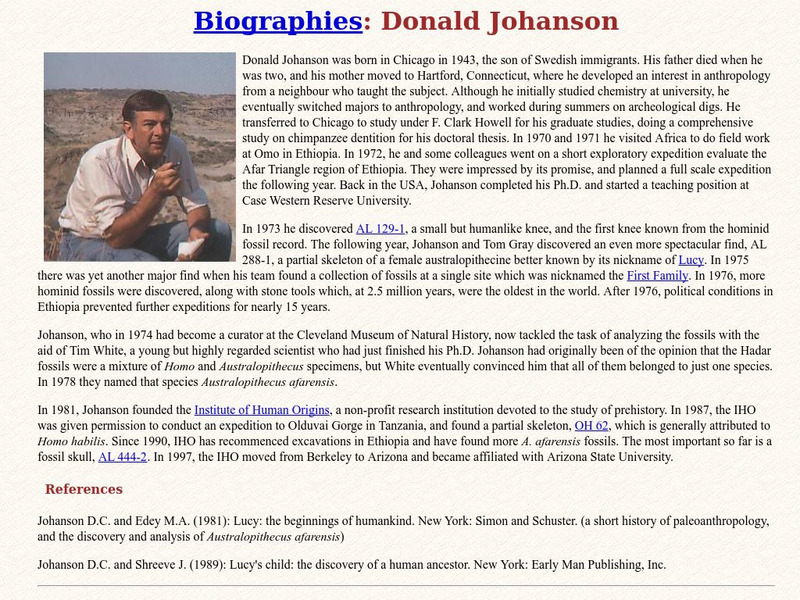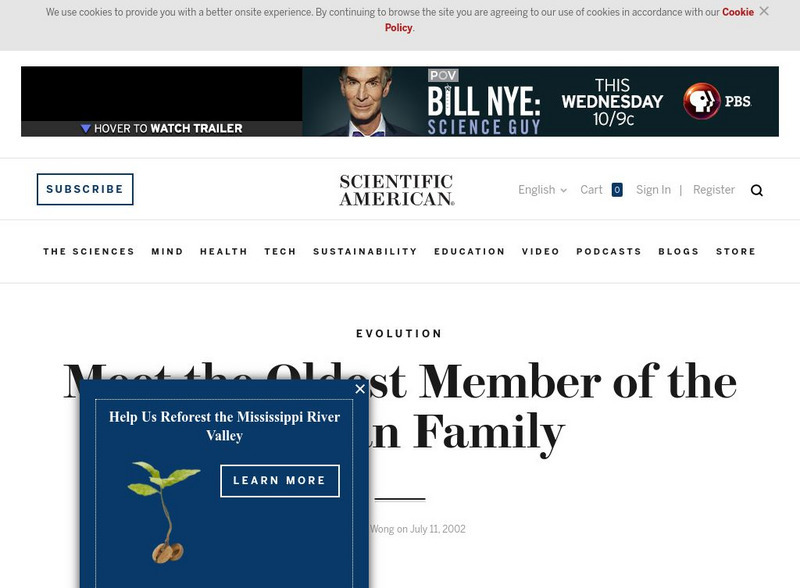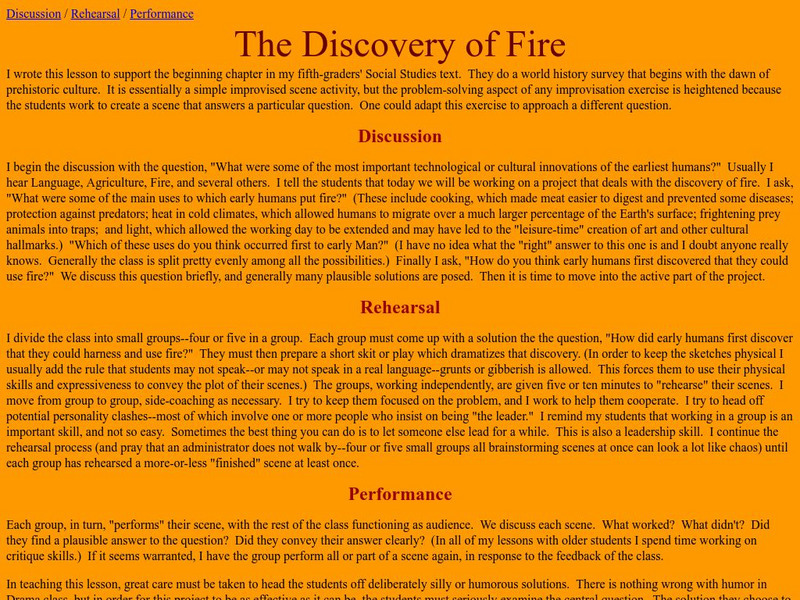PBS
Pbs Learning Media: The Transforming Leap, From Four Legs to Two
John Noble Wilford, a "New York Times" science writer, outlines various hypotheses on the origin of bipedalism.
PBS
Pbs: Nova: The Boldest Hoax
Beginning with a description of a NOVA program on the scientific hoax of the Piltdown Man, this site also offers a podcast interview with an archeologist, a transcript of the program, and a teacher's guide. While there is no proof of who...
Other
Institute of Human Origins: Becoming Human
Multimedia-rich guide for anyone making their way through a study of human origin. Find information and analysis about the fossil record, comparative anatomy, theories, and the cultural adaptations of humans and their ancestors. With an...
Other
Archaeology.info: Homo Habilis
This Archaeology.Info page contains information on the species Homo Habilis. The site includes an introduction, diagnostic features, conclusion, and bibliography.
Indiana University
Ensi: Comparison of Human: Chimpanzee Chromosomes Lesson
This is a great lesson plan that combines Karoytypes and evolution. Students will recognize that the chromosomes of chimpanzees and humans are remarkably similar, then correlate that to their evolutionary relationship.
PBS
Pbs: Leakey Family Discovers Human Ancestors
The PBS site covers the Leakey family and their discoveries in Olduvai Gorge in Tanzania. This information was part of a PBS exploration of human evolution.
PBS
Pbs Learning Media: Riddle of the Bones
At the online companion Web site of "Evolution," the seven-episode series on PBS, piece together clues to how one of our early ancestors looked as you examine images from four significant fossil finds of Australopithecus afarensis.
Archaeological Institute of America
Early Homo Erectus Tools in China
An article which describes a fossil site in eastern China where evidence has been found that Home erectus may have been active in eastern China some 400,000 years earlier than scientists believed. The authors also summarize the debate...
National Geographic
National Geographic: Geostories: Hominin History
Launch the GeoStory to find out about hominins. There are many, many extinct hominins, a fraction of which are represented in this activity.
Read Works
Read Works: A Distant Relative
[Free Registration/Login Required] An informational text about a humanoid skull discovered in 2001. A question sheet is available to help students build skills in reading comprehension.
Talk Origins Archive
Talkorigins: Biography: Donald Johanson
A biography of Donald Johanson, an anthropologist who has discovered many homo erectus skeletons.
Smithsonian Institution
Smithsonian Education: Decoding the Past
The Smithsonian offers students a background on what archaeology is and what an archaeologist does. Several lesson plans are also provided.
Other
Fossil Record
This effective site traces the history of modern man from his early ancestors (Australopithecus Afarensis) to Homo Sapiens sapiens.
PBS
Pbs News Hour Extra: Scientists Discover Oldest Human Ancestor
Scientists have recently published their research into fossil bones from Ethiopia that they say came from an ancestor common to both humans and chimpanzees. They have named the ancestor Ardipithecus ramidus. In the articles and video,...
Travel Document Systems
Tds: Malawi: History
Learn about Malawi's history from its paleological beginnings to its recent elections. Information is from the U.S. State Dept. Background Notes.
Scientific American
Scientific American: Oldest Member of the Human Family
This article, published by Scientific American (July 11, 2002), highlights the discovery of a nearly complete skull of the oldest and most primitive member of the human family known yet. This fossil, found in central Africa, contains a...
Blackdog Media
Classic Reader: Before Adam by Jack London
Read the full text of "Before Adam" by Jack London which tells the story about a man who dreams he lives the life of an early hominid.
BBC
Bbc: The Discovery of Fire
A brief but nice article which summarizes some of the theories concerning the discovery and use of fire by early humans.
Other
Personal Site: The Discovery of Fire
A firth grade lesson designed to introduce students to the discovery of fire and how early man might have discovered how they could use "fire".
Discovery Education
Discovery Education: Apes to Man
This lesson plan explores the primates in the African savannas that were the first animals to walk erect (bipedalism), which is a milestone in human evolution.
University of Oxford (UK)
Pitt Rivers Museum: Methods of Making Fire
An informative article summarizing the history of fire, how humans have used it and the various methods humans have used to start a fire.
BBC
Bbc History: Archaeology: Hunt the Ancestors
Role-playing game lets players explore many facets of archaeology by attempting to rescue a prehistoric burial site from destruction. Players quarry and analyze artifacts and are constrained by both time and budget. Archived.
Wikimedia
Wikipedia: Australopithecus Anamensis
Wikipedia's entry on Australopithecus anamensis. It discusses its scientific classification, age and its posture.
Other
Cartage.org: Australopithecus Afarensis
This essay provides a picture along with brief physical description of one of modern man's earliest ancestors.
Other popular searches
- Early Hominids
- Paleontology Hominid
- Hominid Lineage
- Evolution of Hominids
- Hominid Skulls
- Ice Age Hominids
- Hominid Species
- Hominid Cranium
- Hominids Table
- Hominids Lucy
- Hominid Evolution
- Hominids and Humans


